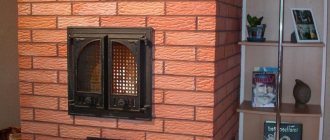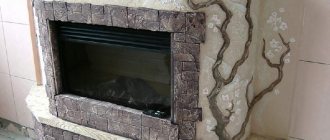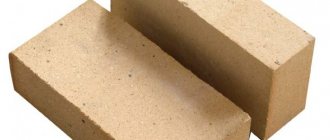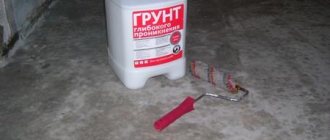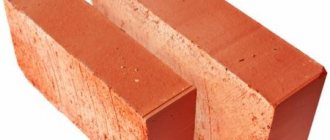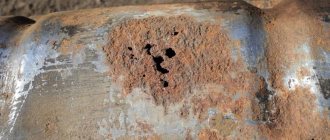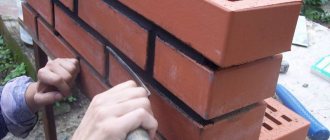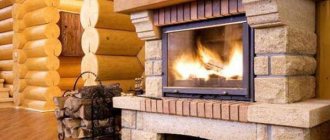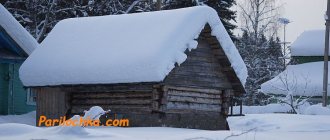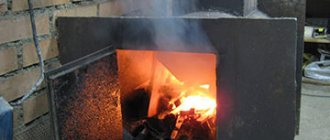The best situation is when the owner of a country house (for example) starts building a bathhouse, having clarified for himself as many issues related to it as possible. For example, the question of what kind of stove he is going to install will be very important, because it determines whether preparatory work is needed for it during the construction period and to what extent . And if he is going to cover the stove in the bathhouse with bricks, then he needs to make a base of appropriate size and strength. However, the question of how to line an iron stove with bricks may arise long after the construction of the bathhouse is completed. In this case, the matter may not be limited to simply erecting small walls, but will (possibly) even require dismantling the furnace. In this article we will sequentially analyze each option for the development of events in different scenarios.
Reasons to line the stove in a bathhouse with bricks
Metal sauna stoves lined with brick
The decision must be made carefully, so we will name the reasons why an iron stove is lined with bricks in a bathhouse.
Unfortunately, the metal stove itself is a source of not only rapid heat, but also hard infrared radiation, which burns the skin from a distance, without contact with the object . In addition, a rapid increase in temperature in the bathhouse leads to dry air , and this is a big obstacle to creating the correct bathhouse microclimate. The third significant reason is that the metal not only heats up quickly, but also cools down quickly, and in a bathhouse this leads to excessive consumption of firewood and unnecessary movements.
Brick is an artificial stone , and therefore it takes longer to heat up than metal and gives off heat much longer. to eliminate the main disadvantages of a metal stove relatively cheaply (compared to natural stone) : make the radiation softer, warm up longer, but without drying out the air, increase the efficiency of the stove by retaining heat from wood burned in the stove longer.
Bricks for lining furnaces
Not everyone is suitable for a heater. Sand-lime brick is not suitable. It will collapse very quickly due to temperature.
If you want a long-lasting stove, use a fireproof one (made from fireclay clay). It is more expensive than the usual one (red), and it doesn’t look very good. But for decorative masonry, the outside can be lined with ordinary brick with a textured surface (hollow brick will be somewhat preferable, since it accumulates heat better). There are two types of fireproof: hollow and solid. Choose a full-bodied one.
But if fireclay is not affordable, take red (and also full-bodied).
Creating a foundation before covering an iron stove in a bathhouse with bricks
The problem is that the story begins long before the stove in the bathhouse is lined. And it begins with a calculation , without which you will not be able to correctly estimate the weight of the stove together with the screen, and therefore, you will either waste your money on the foundation, or, conversely, underestimate the weight and ruin, at a minimum, the floor.
Calculation after which a decision is made on the choice of base
You need to collect the following information:
- dimensions (length, width, height) and weight of the future or existing stove (manufacturers usually post similar information on their websites);
- mass of stones, in ovens with a closed and/or open heater (also indicated by the manufacturer);
- hot water tank (!about stoves with a tank here) - if it is assumed, then its weight and the volume of water it can hold (1 l = 1 kg).
Next, you will have to figure out what kind of brick you will use - red fireproof or fireclay. Since a discussion of the types of bricks awaits you below, here we will indicate the size of only ordinary red refractory brick, which, by the way, is the leader when choosing to cut an iron stove in a bathhouse with facing bricks.
So, the dimensions and weight of one standard brick are 250 mm in length, 120 m in width, 65 mm in height, weight 4 kg.
Now estimate how many bricks will be needed for 1 row if you place them along the walls of the stove with a minimum gap of 5 cm between the stove and the screen?
There are different screens - on four sides, on three, on two - choose your option, focusing on the height of the stove, and calculate how many rows will fit.
By the way! Do not forget that the brick in the masonry can also be laid in different ways (1/2, quarter and other options), and this will affect the base area.
By multiplying the number of rows by the number of bricks in a row, you will get the total amount of the required material, as well as its mass , multiplying the result by 4.
Add the mass of the screen with the mass of the oven, stones, tank, water in the tank. Add 20% as a safety margin.
If the mass is less than 700 kg , you can safely make the base directly on the floor boards. Otherwise, you will have to build a separate foundation from the sauna stove.
Foundation on foundation
Let's start with the more difficult one. You have calculated everything and it turns out that without a foundation there is no way. The task is easier if you are at the construction stage, otherwise you may have to dismantle the stove, the old base, or part of the floor.
IMPORTANT! You know the dimensions of the foundation by area from the calculations made above. This is a platform formed by bricks on the sides of the stove. Add 10-15 cm to it on all sides.
Start digging a hole. If the soil can withstand it (say, if when calculating the foundation for the bathhouse, it turned out to be shallow, then there is no need to deepen the stove too much), make the depth half a meter and fill it 3/5 with a mixture of sand and gravel, or just crushed stones.
Keep in mind! Not only should the stove and bath foundations not touch each other, it is recommended that the distance between them be at least 5 cm.
On top of the cushion, a screed is usually made from a 1:4 cement-sand solution.
Waterproofing and formwork are placed on top of the screed and a concrete foundation is poured, possibly reinforced, 20 cm high. It will be below floor level.
Note! When drying concrete, it must be frequently sprayed with water to prevent it from cracking.
The concrete is again waterproofed , after which foundation bricks - fireproof red or fireclay, which are placed on a clay mortar . Height - 1-4 rows. Do not forget to check the horizontal level at each stage.
After that, install your device and begin to build a brick screen for a metal stove in the bathhouse.
Floor base
It is easier to cover a metal stove in a bathhouse with bricks if the base is made directly on the floor. However, you need to take into account the structure of the floor and first calculate whether specific lumber will withstand the upcoming load.
ESSENTIAL! In an old bathhouse, a mandatory procedure will be to open the floors and check the beams and joists for rot and other damage. Replacing the damaged one is inevitable due to the increasing load.
Let's start with the fact that the stove does not press on the floor pointwise, but approximately evenly, because it stands on a brick base. This means that we must add the weight of the foundation bricks to the previously calculated total for the stove and screen, and then divide by the area occupied by the latter, measured in square meters. As a result, we get the load per square meter of floor surface under the stove.
In the table below you will find the parameters of beams (width, height, thickness) that will withstand the specified maximum load - 150, 250, 350, 450 kg per square.
If yours don't fit, don't worry - beams can be reinforced with channels, steel strips or rods, as well as wood overlays.
If the beams are located at a distance of a meter or more, craftsmen advise placing an additional beam between them. For example, pine with a section of 100x150 mm.
The next thing to worry about is lags . There are also maximum loads for them. Look for the values in the table below.
If there are no color marks, then the values are not close to the tensile strength. Green color is an acceptable, but already limiting value . Red - unacceptable !
Joists are easier to replace than beams.
So, having completed the preparatory work with the floor, you are ready to begin creating the foundation. To do this, markings are made on the floor with an allowance from the screen of 10-15 cm. If any side or sides of the stove are not covered by the screen, then the allowance is made from the stove itself.
Do not forget that fire safety rules require protecting the space in front of the firebox, preventing sparks from touching flammable material. You can either extend the refractory half a meter in front of the firebox, or put a metal pre-furnace sheet there.
After marking, a sheet of refractory material - the material of your choice: asbestos, ceramic fiber or another option. The edges are secured to the floor using self-tapping screws.
asbestos cardboard (asbestos cardboard)
The next layer is the base bricks, the height of which can be, for example, 20 cm. Use only solid refractory bricks - red or fireclay. The solution is clay or with a small addition of cement . Alternatively, you can buy masonry mixture .
Most often they are limited to two rows of masonry . Excess solution is removed without waiting for it to dry. Evenness is also checked immediately using a level - this should not be neglected.
After such lengthy preparations, we are already close to the story of how to line an iron stove in a bathhouse.
Furnace base arrangement
Before starting work, it is necessary to inspect how strong the floor base is for this purpose. The masonry has significant weight and this must be taken into account. You can calculate the total mass that the base must support.
To do this, we calculate the required number of bricks: multiply the pieces of bricks in one row by the total number of rows. Then we multiply the result by the weight of one product. Now we know the weight of the brick screen.
An insufficiently strong base for the stove can be strengthened with the help of additional supports that are installed under the load-bearing floor beams.
After assessment, the base is marked. It must be taken into account that the surface of the metal stove must have a distance of 3–10 cm from the inner surface of the wall. If this is reduced, the brick will warm up better and faster, but this may reduce its service life.
If the stove is installed on a floor made of wooden boards, then the lining is mounted on an iron or asbestos sheet, which ensures fire safety.
Columnar foundation
If installation of a conventional strip foundation is not possible, then a columnar foundation is built . It is durable and reliable. Its installation does not require additional waterproofing; its design is simple and does not require large financial expenditures.
The first layer of brick lining is laid on the finished perimeter of the foundation.
Solid foundation
If you are not satisfied with a columnar foundation, you can install a solid one . It is installed in stages:
Any type of foundation should not be in contact with the wall foundation. The distance between them of at least 5 cm is filled with heat-insulating material.
Lining an iron stove with bricks in a bathhouse
All the variety of options can be easily demonstrated by breaking them down into points.
Types of linings
Photo of the finishing of the stove in the bathhouse (at the bottom of the vent for controlling convection)
If you surround the oven with brick walls on four sides, it will be a complete lining . Otherwise - partial . Regardless of how many walls will not be enough to complete, there is a significant difference between one and the other type. It is controlled by convection.
Simply put: this matters only for lovers of the Russian bath, the stoves for which are covered in a separate article. If the convection is controlled, you turn it off at the right moment, the hot air from the heated metal heats not the steam room, but the walls of the brick sarcophagus. They transmit softer heat. Heating slows down. You get the opportunity to maintain the conditions of a Russian bath - 55-60 degrees and about the same humidity.
To control convection, vents with doors or plugs made from pieces of brick are made at the bottom and top of the screen - when open, they do not interfere with air movement.
Even with one open wall near the stove, you can only count on a sauna. And the functions of the screen will be reduced to protection against burns, heat accumulation and fire safety. Which, in general, is also not bad).
Ways to fence off an iron sauna stove with bricks
Bricks for lining a metal stove in a bathhouse can be laid in different ways. Let's list them all.
By the presence or absence of empty space between bricks:
- Solid masonry is rarely used because it creates an obstacle to convection and significantly reduces the efficiency of the furnace.
- Laying in a row - gaps in each row, which is also an infrequent solution, because it also reduces the efficiency, this time of the screen itself. Heat actively escapes through vents, convection is uncontrolled, analogous to the absence of one or more walls.
Downstairs and upstairs vents with doors are the most common option. Controlled convection.
According to the position of the bricks in the masonry:
- Brick is a rare type of masonry, which at the same time wastes a lot of material and reduces the efficiency of the furnace, since it takes too much time to heat a steam room with such a screen.
- Half a brick is the best option, which is what most people do. The thickness of the walls and the stability of the structure are not satisfactory. But if desired, you can reinforce it by placing wire or mesh in the seams between the rows.
- A quarter brick is a rare option, because the wall is both thin and unstable. The latter circumstance can be compensated for by reinforcement with wire/mesh, but it is still recommended to install such a screen only if you have the appropriate experience.
What kind of brick to line an iron stove in a bathhouse
Let us say right away that sand-lime brick is not suitable for these purposes at all. But what kind of brick can be used to line a steel stove in a bathhouse: red refractory or fireclay .
Both are better full-bodied. However, one must take into account that today you can find bricks on sale not only of different sizes, but also of varying degrees of decorativeness. In particular, there are options specifically for laying stoves and fireplaces. The type of brick to cover an iron stove in a bathhouse also depends on the distance you leave between the screen and the stove . Let's say, if it is extremely small and amounts to 1 or 2 cm, then the heating of the bricks will be strong, which determines the choice of fireclay. However, no one (or almost no one) does this. The minimum distance is 5 cm. Even in this case, air flows will not allow the brick to overheat regularly. And if it is increased to 7-10 cm, then the inner surface of the bricks will completely stop heating above 200 degrees. The presence of lower vents also reduces this figure.
Advice! Fireclay is more expensive, so it should be used only where its fire-resistant properties are really important - for example, it is used to line the inside of the firebox. Red fire brick is enough to create a screen.
Having figured out what kind of brick to line a metal stove in a bathhouse, let’s move on to the composition of the solution.
What solution is suitable for lining the stove?
There are quite a few options for masonry mortar. The most commonly mentioned components are clay and sand with the addition of cement, but variations are possible.
- You can take clay and cement 50x50, and then add sand in an amount from 1/10 to 1/3 of the total amount.
- Another option: take twice as much sand as clay and add half as much water as clay. As you can see, this is a cementless option.
- Another option without cement involves equal parts of sand and clay and adding 100 grams of ordinary table salt per bucket of solution.
- Mortars with fireclay powder are less durable than those made from ordinary clay; they are best used for grouting joints inside a masonry well. The proportions are different, for example, this: clay 60%, fireclay powder 30%, cement 10%. Or take equal amounts of cement and sand, add 10-30% sand and 20-25% fireclay powder to them.
The clay can be pre-soaked. Either gently crush the dry mixture on a sheet or in a shallow bath with a small amount of water. And only after gaining plasticity is everything else added to it.
We recommend that you simply buy the kiln masonry mixture at a hardware store.
IMPORTANT! Many people advise letting the solution sit for half an hour or a little more before starting to work with it. During this time, the water is distributed, the mixture thickens, and the solution becomes ready for laying.
Technology of cutting an iron stove in a bathhouse with facing bricks
Even before you start preparing the masonry mortar, you need to make sure that the bricks are also ready. Since in a dry form they are able to take moisture from the solution, it is customary to soak them in water in advance.
The process takes quite a long time - at least 12 hours . This is done both if you take a new brick and if it has already been in masonry. In the latter case, by the way, you should not waste time on completely cleaning the old solution.
On the finished brick, you should check the quality of the mortar - if it does not tear or spread, then its consistency is correct, and you can start laying. Usually they are laid in half a brick, the rows are staggered. Each row is carefully checked for horizontal evenness using a level.
Advice! To maintain the correct distance of the seams, you can use special overlays, which are then removed.
Don’t forget that the screen can be reinforced, which we already mentioned above.
The laid out screen must stand for at least a daybefore you start cleaning off excess solution on its surface. A drill with a stiff metal brush can be used as a cleaning tool .
After this procedure, it will be enough to simply run a regular dishwasher brush in a soapy solution, and the masonry will be clean.
About round ovens
A horizontal round sauna stove, as mentioned above, does not require cladding, but the construction of a screen around it. How to line a round stove with bricks to increase the duration of heat transfer is illustrated in Fig. Below is an example of a horizontal furnace with a flat bottom; Here you can see all the main technological methods of this type of work:
Brick lining of a round stove
- The cushion under the stove is laid with working bricks on a clay-cement solution, and on it with fireclay on a clay stove (highlighted in tone).
- To the level of the greatest width of the body, the masonry is carried out from the bottom up, first with thin fireclay bricks (fireclay tiles) with dowels hemmed onto a wedge.
- The vault is laid out from sectored fireclay bricks. The thickness of the seam must be maintained within 3-6 mm, respectively. choosing the standard size of the sector brick.
- The seams of the fireclay masonry are cut to a depth of 3-5 mm.
- After the fireclay masonry has dried, it is coated with a layer of clay-cement solution approx. 5 mm.
- If the oven is large, the coating is done with belts so that the outer lining of working bricks is laid on top of the mortar that has already begun to set.
- The thickness of the seams of the external cladding is maintained within the range of 5-12 mm, for which the beds of facing bricks are oriented along the longitudinal axis of the furnace or across it.
As for vertical round stoves, most often they can be lined using mostly sector bricks, unless the stove is located close to the wall. But, generally speaking, there is no need to line such stoves with brick. Almost all vertical round stoves are channel or bell-type stoves in a steel case. Brick cladding will only ruin their heating technology. Such stoves need to be made beautiful by stripping/painting, tiling/porcelain tiles, etc. in ways that do not disturb the heat cycle of the stove.
Additionally: how to line an iron stove in a bathhouse with stone
Here we see two options:
- or you line it with brick, and then put decorative tiles made of natural stone on top - this will simultaneously increase the heat capacity of the casing, increase the heating time, and also change the design of your stove;
- or you should purchase one of the ready-made stone casings for stoves, which are cut in workshops to fit any model, as well as from any available stone. The most popular are casings made of soapstone (soapstone is softer, magnesite is better in this regard) and coils. However, you can find interesting options from other rocks.
For more information on using stones for lining, see this article.
Why do you need a lining?
Invented more than a hundred years ago, the potbelly stove is still popular today due to its positive properties:
- Light weight;
- Long service life;
- Compactness;
- Mobility;
- Fast heating of the room;
- Easy to install.
It has few disadvantages:
- Poorly retains heat;
- The surface becomes very hot during combustion.
To eliminate these phenomena, brick walls are laid around the metal structure.
As a result, the oven receives new positive properties:
- When burning fuel, a metal stove quickly heats up and gives off heat. As soon as the fire goes out, the stove quickly cools down and the temperature in the room drops. The bricks surrounding the surface of the furnace heat up and, unlike metal, release thermal energy slowly. Lining the stove with brick maintains a comfortable temperature in the room longer.
- When fuel burns, the metal becomes so hot that touching it can cause a burn. The surface of the brick does not heat up to such a high temperature. The heat from the heating device becomes softer and more evenly distributed throughout the room.
- Brick gives the stove an attractive appearance. Thanks to its qualities, it can turn a simple stove into a decorative element that decorates the interior.
- The brick shell “breathes”. During the heating process, moisture from the brick evaporates into the room and is absorbed during cooling. As a result, the microclimate improves - the air will not be too dry or too humid. There is no dampness or mold in a room with a brick stove.
Useful video
The first video will be useful for those who have never laid a brick themselves.
A video about how to get a Russian bathhouse by lining a metal stove with brick yourself and cheaply
In the following video, Teklar demonstrates the principle and procedure for lining its own furnace with an external firebox.
*** Well, now you are fully armed with the knowledge of how, why and what you can line an iron stove in a bathhouse with. We can only wish you success and easy steam!
